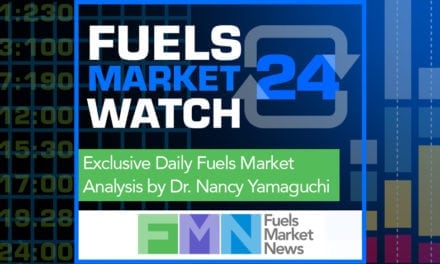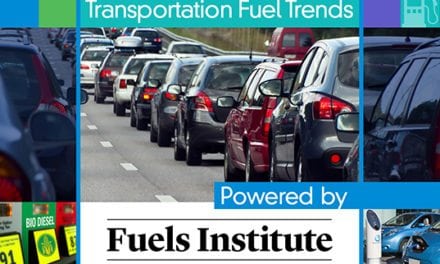“Fueled for Thought” By Joe O’Brien, Source North America Corporation
The future of renewable fuels in the United States is at a political and economic crossroads, and the direction it ultimately takes will significantly impact the future of retail fueling. Driving this industry-wide issue is the Renewable Fuel Standard (RFS), a U.S. energy program that, by many accounts, is showing some flaws.
Many industry insiders suggest the RFS isn’t working as it was originally intended, while others say just the opposite. Why? The answer is a complicated web of industry developments and events that includes the blend wall, fracking, engine technology limitations and consumer preferences — to name just a few.
RFS: Then and Now
The Renewable Fuel Standard is a federal program created under the Energy Policy Act of 2005 that requires fuel sold in the United States to contain a certain minimum annual volume of renewable fuels. Originally slated to continue until 2022, Congress established the program to reduce greenhouse emissions, expand the nation’s renewable fuels sector and reduce reliance on foreign oil. It was developed during a time when oil prices were soaring and when the U.S. was still importing the majority of its oil.
But times have changed significantly since the RFS program originated 10 years ago. Since then, the U.S. has reduced its dependence on foreign oil, and consumer demand has not kept pace with the EPA’s original long-term vision for sustainable, renewable fuel sources. These dynamic conditions have been a challenge for the EPA, which has struggled recently to administer the RFS and its volume requirements.
After unsuccessfully meeting 2014 and 2015 deadlines for setting RFS volume requirements, on May 29, 2015, the EPA announced its proposed biofuel volume requirements for 2014, 2015 and 2016, as well as the biodiesel volumes for 2017. The proposed volumes aim to align energy-responsible policies with the real-world conditions of the current marketplace.
In its proposal, the EPA based the 2014 volume requirements on the actual amount of biofuels produced and used that year. The EPA’s proposed 2015 and 2016 volumes are lower than the volumes originally outlined by Congress, but respective to the 2014 volumes, they still represent an increase year-over-year:
Total Renewable Fuels:
- 2014: 15.93 billion gallons
- 2015: 16.30 billion gallons
- 2016: 17.40 billion gallons
In its regulatory announcement, The EPA describes the 2015 and 2016 volumes as “ambitious.” Reaction to the proposed RFS has been somewhat predictable. At a public hearing the Renewable Fuels Association testified that, by waiving the RFS due to distribution and consumption issues the EPA didn’t follow the tenets of the original statute. The American Petroleum Institute was pleased the EPA lowered the volumes, but was overwhelmingly critical of the standard’s long-term strategy to promote a fuel that it says most consumers don’t want and whose environmental benefits are questionable.
Where the Blend Wall Meets the Fuel Island
Most unleaded gasoline sold in the U.S. contains some ethanol — up to 10% (E10), which is the percentage of ethanol that is widely accepted as safe for engine performance across the spectrum of vehicles still in use today. When Congress passed the original law in 2007, lawmakers did it with the assumption that overall gasoline consumption would continue to rise. However, due in part because of advances in fuel efficiency and changing driving habits, gasoline consumption in the United States has declined the past several years. With less gasoline being consumed in general, the rate of ethanol blend consumption has dropped accordingly. Somewhat ironically, it seems that part of the reason the EPA’s RFS volumes aren’t in line with proposed levels is because the U.S. has in fact become more responsible in its overall fuel consumption, one of the underlying principles of the original RFS.
In addition, consumer demand for higher ethanol blends, while growing, still represents only a small fraction of the fueling landscape. Some industry groups have taken a firm stance that high ethanol content damages engines, thwarting market adoption of flex fuel engine technology. Marine, motorcycle and automotive groups, for example, remain largely guarded about the safety of higher ethanol blends, which they say could cause rapid engine component degradation – and ultimately – ¬ high maintenance and repair bills for consumers.
Although research by the Department of Energy showed that fuel blends containing up to 15% ethanol (E15) are safe for light duty vehicles manufactured after 2001, E15 remains the exception at the fuel island, not the rule. And consumption of E85, while increasing, still only comprises a small percentage of fuel sales. With the limited demand for the E15 and E85 (approximately 2,600 of 127,000 C-store fuel stations now sell E85 and less than 300 sell E15), the supply and distribution for the higher ethanol blends remains constrained due to market perception.
Where Do We Go From Here?
Despite the fact that current consumption of renewable fuels is lower than Congress had originally hoped for, total consumption has grown over the past five years: according to the Alternative Fuels Data Center, consumption of ethanol and biodiesel increased over 300% from 2009 to 2014. E15, in particular, is a fuel to watch. Several large retailers have recently introduced — or announced plans to introduce — E15 fuel to their forecourts, and the Chicago City Council recently considered an ordinance that mandates the sale of E15 at some gas stations. If the automotive and petroleum industries adopt E15 and find ways to have it improve typical engine performance, it could help the RFS meet its original objectives and create a major shift in consumer demand for ethanol-blended fuels.
That notwithstanding, many are questioning the relevance of the RFS in today’s U.S. economic climate. Due to the hydraulic fracturing boom, the U.S. is currently more self-sufficient in terms of oil production than it has been since the early ‘70s, which has significantly bolstered energy security — at least in the short term. Many critics are calling to either overhaul the standard or repeal it altogether, suggesting that it’s fundamentally incompatible with current economic conditions. Perhaps the solution to solving the RFS riddle might be found in the answer to this question: Why is the EPA’s ultra-low sulfur diesel program succeeding? According to the Diesel Technology Forum, clean diesel engines are “helping meet energy security, greenhouse gas and clean air objectives.” It doesn’t sound that different than Congress’s original goal for the RFS.
Nevertheless, the RFS remains, and it looks to remain for some time. On the same day the EPA announced its new proposed lower RFS volumes, the USDA announced the availability of up to $100 million in competitive grants to match state funds for installing blender pumps. Certainly, that is not coincidental. This incentive toward building a fueling infrastructure complementary to ethanol blends sends a message that blended fuel will continue to get support from those who can help steer its use.
Although no fuel equipment supplier can forecast with any certainty the road the RFS will pave for fuel demand, they can assist retailers with equipment investment decisions that will prepare their stations to cater to evolving consumer habits. While trusted equipment advisers will never tell you what you should blend, they can absolutely steer you towards an equipment solution that can help efficiently position your facility to fit the needs of your customers, helping maintain and drive sales as the fuel landscape shifts.
 Joe O’Brien is Vice President of Marketing at Source™ North America Corporation. He has more than 20 years experience in the petroleum equipment fueling industry. Contact him at [email protected].
Joe O’Brien is Vice President of Marketing at Source™ North America Corporation. He has more than 20 years experience in the petroleum equipment fueling industry. Contact him at [email protected].








